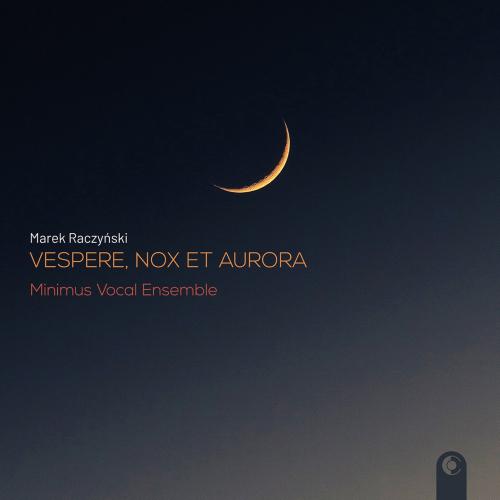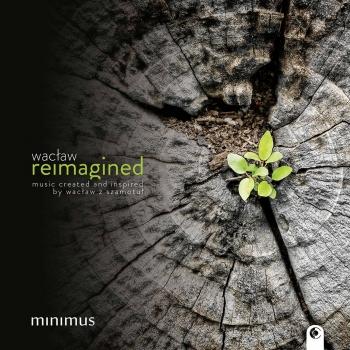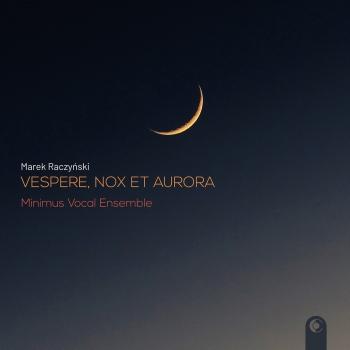
Vespere, nox et aurora Minimus Vocal Ensemble & Sławomira Raczyńska
- Marek Raczyński: Christe, qui lux est et dies:
- 1 Raczyński: Christe, qui lux est et dies 05:11
- La noche oscura:
- 2 Raczyński: La noche oscura: I. Dialogo I 02:41
- 3 Raczyński: La noche oscura: II. Cancion I 03:31
- 4 Raczyński: La noche oscura: III. Dialogo II 03:19
- 5 Raczyński: La noche oscura: IV. Cancion II 02:54
- 6 Raczyński: La noche oscura: V. Dialogo III 02:35
- 7 Raczyński: La noche oscura: VI. Cancion III 04:53
- 8 Raczyński: La noche oscura: VII. Dialogo IV 02:15
- 9 Raczyński: La noche oscura: VIII. Cancion IV 03:43
- Sol, ecce surgit igneus:
- 10 Raczyński: Sol, ecce surgit igneus 05:08
- Silence:
- 11 Raczyński: Silence 04:08
- Veni creator spiritus:
- 12 Raczyński: Veni creator spiritus 05:59
Info zu Vespere, nox et aurora
In the part devoted to the beginning of the world, the Bible says that God first created heaven and earth, formless and empty. Darkness was over the surface of the deep, and the Spirit of God was hovering over the waters. That is when God said: “Let there be light!” And day severed itself from night. That was the morning and evening of the first day.
The album “Vespere, Nox et Aurora” is a peculiar tribute to the light, to the immemorial order of the world in which night and day are not opposed to one another. They need each other, just as we do. However, the path towards the light is long and it requires facing oneself and the demons of the night. Although light and shadow are inseparable, we continue to fear everything that is unclear or invisible to us. Thus, the opening composition, “Christe, qui lux es et dies”, was created to a fragment of the hymn from a Compline evening service. The piece, devoted to the memory of Wacław z Szamotuł, heralds the night. The lyrical melody of sopranos is laid softly upon repetitive sounds of the remaining voices, and as the piece approaches the end, it is filled with even more intriguing cluster consonances. They plant a seed of uncertainty within us and ask for a solution, which is nowhere to be found yet, since the pilgrimage through the night has only just begun. The pillar of “La noche oscura”, the piece the lyrics of which have been kept in its original, Spanish version, is the mystical hymn of Saint John of the Cross. Instrumental parts serving as interludes (Dialogo) have been set up against vocal fragments (Cancion), while the story is based on love as an anchor in the darkness of the night and the power of it, bringing oblivion and making it possible to make it to sunrise. Vocal and instrumental parts are contrasted with each other, like two worlds – or day and night – where dream is interwoven with reality. “Sol, ecce surgit igneus” is a hymn for Lauds. It brings us the long-awaited dusk. The sound is becoming more intense, crescendos in chords illuminate the composition, making it more elevated. As the composer explains, “the ascending theme based on successive sounds of the scale was inspired by Arvo Pärt’s «Solfeggio», with only a few significant elements that make it different from the original. Firstly, I used a scale with raised 4th degree, which generates different sound qualities. Secondly, the sequence of sounds is constantly modulated, which allowed me to use the full array of sounds (symbols of entirety, circle and sun) in the first sixteen bars. The next piece, “Silence...”, composed on commission for the Choir of the Centre for the Thought of John Paul II, allows the listener to reflect upon the creation of the world and the mysteries of light, spirit and nature. “Silence – why are you silent? How carefully you have hidden the secret of your beginning” – writes Saint John Paul II in the “Roman Triptych” cited above. The voices go from adding meaningful senses, reinforced by the recurring theme, to co-creating the harmony, deliberately tinted with unobvious interplays. As if, paradoxically, it was possible to hear something deeper in silence – like silence in which we can hear... silence. “Veni Creator Spiritus” is an impressive finale of the spiritual journey, inspired by the works of Stefan Stuligrosz. The composition includes a suspenseful beginning, an aleatoric final, quotes from a Gregorian chant and a memorable, ostinato-like rhythmic part sung by male voices. They overlap with descending triplets in female voices, creating an unforgettable impression of calling upon mortals begging for peace – thirsty of light in their own hearts. The concept of the album is very consistent and well-thought. It is a successful combination of early music and ambitions of contemporary music, chords with characteristic, thrilling semitones, quotations and thoughts drawn from literature. Despite the opulence of applied measures, the combination is engaging, reliable and honest.
Minimus Vocal Ensemble performing Marek Raczyński’s compositions sounds vibrant and soft. In each of the pieces it prepares us for what is inevitable, because (luckily for us) light possesses this very feature. We wander through the night, clad in sounds, along the astonishing and hesitant verge between evening and morning. We also hope to find a solution to tough and intriguing greys of our daily lives. Thus, the accompanying music brings us both reflection and consolation. On the other hand, gentle consonances with extended tonality naturally support us on our path to a new tomorrow. New meaning better? No matter what, it is certainly worth coming.
Minimus Vocal Ensemble
Sławomira Raczyńska, direction
Minimus Vocal Ensemble
Was founded in 2010. It is focused on a cappella singing, with its repertoire including mainly Renaissance music and pieces composed in the 20th and 21st century representing the spirit of ancient times. Minimus frequently takes part in projects related to historically-informed performances of early music. The ensemble enjoys cooperating with contemporary composers. Its portfolio includes several preview performances of a cappella choral pieces. It performs throughout Poland, placing an emphasis both on high artistic level and well-thought dramaturgy of its concerts. Minimus Vocal Ensemble recorded two CDs - “Nie tylko kolędy” (“More Than Carols”) of 2014 featuring innovative carol arrangements and “Media Vita” of 2017, a premiere recording of pieces composed by Marek Raczyński in the form of a monographic album. The ensemble is a winner of numerous national and international choral contests. It was distinguished at such competitions and festivals as the International Sacred Music Festival in Rumia (1st place in the category, 2018), Ars Liturgica National Competition in Gniezno (Golden Diploma 2018, 2014), the International Choral Music Festival in Barczewo (Golden Diploma, 2016) or the Wacław z Szamotuł National Choral Competi tion (1st place in the category, 2011). It was also honoured for the culture of sound and for its exquisite performances of early music. The group is composed of experienced singers rooting from Poznań’s best choirs. Sławomira Raczyńska is the ensemble’s artistic director. First and foremost, however, Minimus is a group of friends who share a passion for polyphonic singing. Their different characters and personalities complement each other in their shared pursuit of beauty.
Sławomira Raczyńska
graduated from the I. J. Paderewski Academy of Music in Poznań with honours in two spe - cialisations: Choral Conducting in the class of prof. dr hab. M. Gandecki and Baroque Oboe in the class of mgr Marek Niewiedział. Since 2016, she has been a lecturer at her alma mater, at the Faculty of Composition, Conducting, Vocal Arts, Theory of Music and Artistic Education. She is also an assistant to the conductor of the Chamber Choir at the Academy of Music in Poznań. She is a winner of the 2nd prize at the 12th National Competition for Choral Con - ductors. Since 2011, she has been working as a choir and vocal ensemble teacher at the Jerzy Kurczewski Choral School in Poznań. In 2010, she founded Minimus Vocal Ensemble, which she leads as an artistic director and a conductor. With her ensembles, she won a number of prizes in national and international choral competitions. As an oboist, she cooperated with Baroque orchestras throughout Poland, such as the Wrocław Baroque Orchestra, MACV ensemble of the Warsaw Chamber Opera or the Polish Orchestra of the 18th century.
Booklet für Vespere, nox et aurora
















